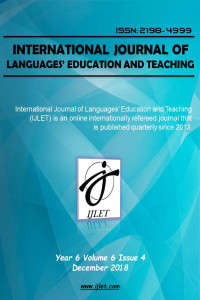Öz
Anahtar Kelimeler
Spanish teaching second language infinitival complement textbook grammar
Kaynakça
- Abbott, A., and Lear, D. (2010). The connections goal area in Spanish community service learning: Possibilities and limitations. Foreign Language Annals, 43, 231–245.
- Adair-Hauck, B., Donato, R., and Cumo-Johanssen, P. (2010). Using a story-based approach to teach grammar. In J. L. Shrum and E. W. Glisan (Eds.), Teacher’s handbook: Contextualized foreign language instruction (4th ed., pp. 216-244). Boston, MA: Heinle, Cengage Learning.
- Benavides, C. (2015). Using a corpus in a 300-level Spanish grammar course. Foreign Lnguage Annals, 48, 218-235.
- Bettencourt, M. (2015). Supporting student learning outcomes through service learning. Foreign Language Annals, 48, 473–490.
- Cerezo, L., Caras, A., and Leow, R. P. (2016). The effectiveness of guided induction versus deductive instruction on the development of complex Spanish gustar structures. Studies in Second Language Acquisition, 38, 265-291.
- Cook, V. J. (1998). Relating SLA research to language teaching materials. Canadian Journal of Applied Linguistics, 1, 9-27.
- Cullen, R., and Kuo, I-C. (Vicky) (2007). Spoken grammar and ELT course materials: A missing link? TESOL Quarterly, 41, 361-386.
- Durán, R., Alonso, P., and Sánchez, M. J. (2007). The study of modal verbs from a pedagogical perspective: an analysis of textbooks and grammars. Revista de Lingüística y Lenguas Aplicadas, 2, 29-37.
Öz
This study examines Spanish textbook explanations of infinitival complements and how they can affect a learner’s second-language acquisition process. Verbs taking infinitival complements are commonly found in mandate and volition verbs, both for Spanish and English. However, while some English verbs take gerunds (María avoids eating/*to eat meat), in Spanish a gerund never functions as the complement of a verb (María evita comer/*comiendo carne). Because of these differences, L1 English learners of L2 Spanish often have difficulty acquiring infinitival complement constructions in Spanish. Specifically, they may employ English-like complement structures, producing such ungrammatical utterances as *Odio comiendo tacos ‘I hate eating tacos’. A compounding factor is that many Spanish textbooks do not emphasize the usages of infinitival complements and, when explanations are provided, they are often vague and insufficient. This study examines Spanish textbook explanations of infinitival complements (intermediate and advanced college-level Spanish textbooks and grammar reference books published in the United States) to determine how they can affect the L2 learners’ second-language acquisition process. In this study, sample interactive activities are proposed as an alternative that can go beyond the traditional textbook explanations.
Anahtar Kelimeler
Spanish teaching second language infinitival complement textbook grammar
Kaynakça
- Abbott, A., and Lear, D. (2010). The connections goal area in Spanish community service learning: Possibilities and limitations. Foreign Language Annals, 43, 231–245.
- Adair-Hauck, B., Donato, R., and Cumo-Johanssen, P. (2010). Using a story-based approach to teach grammar. In J. L. Shrum and E. W. Glisan (Eds.), Teacher’s handbook: Contextualized foreign language instruction (4th ed., pp. 216-244). Boston, MA: Heinle, Cengage Learning.
- Benavides, C. (2015). Using a corpus in a 300-level Spanish grammar course. Foreign Lnguage Annals, 48, 218-235.
- Bettencourt, M. (2015). Supporting student learning outcomes through service learning. Foreign Language Annals, 48, 473–490.
- Cerezo, L., Caras, A., and Leow, R. P. (2016). The effectiveness of guided induction versus deductive instruction on the development of complex Spanish gustar structures. Studies in Second Language Acquisition, 38, 265-291.
- Cook, V. J. (1998). Relating SLA research to language teaching materials. Canadian Journal of Applied Linguistics, 1, 9-27.
- Cullen, R., and Kuo, I-C. (Vicky) (2007). Spoken grammar and ELT course materials: A missing link? TESOL Quarterly, 41, 361-386.
- Durán, R., Alonso, P., and Sánchez, M. J. (2007). The study of modal verbs from a pedagogical perspective: an analysis of textbooks and grammars. Revista de Lingüística y Lenguas Aplicadas, 2, 29-37.
Ayrıntılar
| Birincil Dil | İngilizce |
|---|---|
| Konular | Dil Edinimi |
| Bölüm | Araştırma Makalesi |
| Yazarlar | |
| Yayımlanma Tarihi | 30 Aralık 2018 |
| Yayımlandığı Sayı | Yıl 2018 Cilt: 6 Sayı: 4 |

